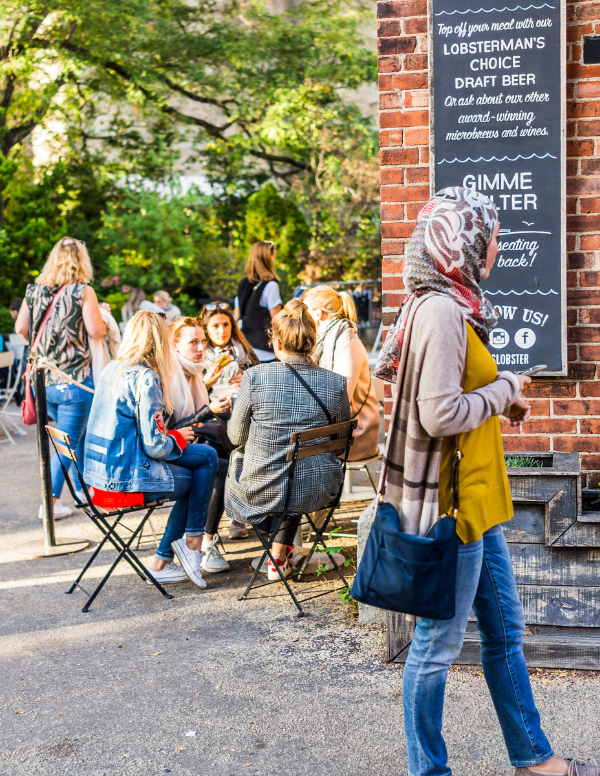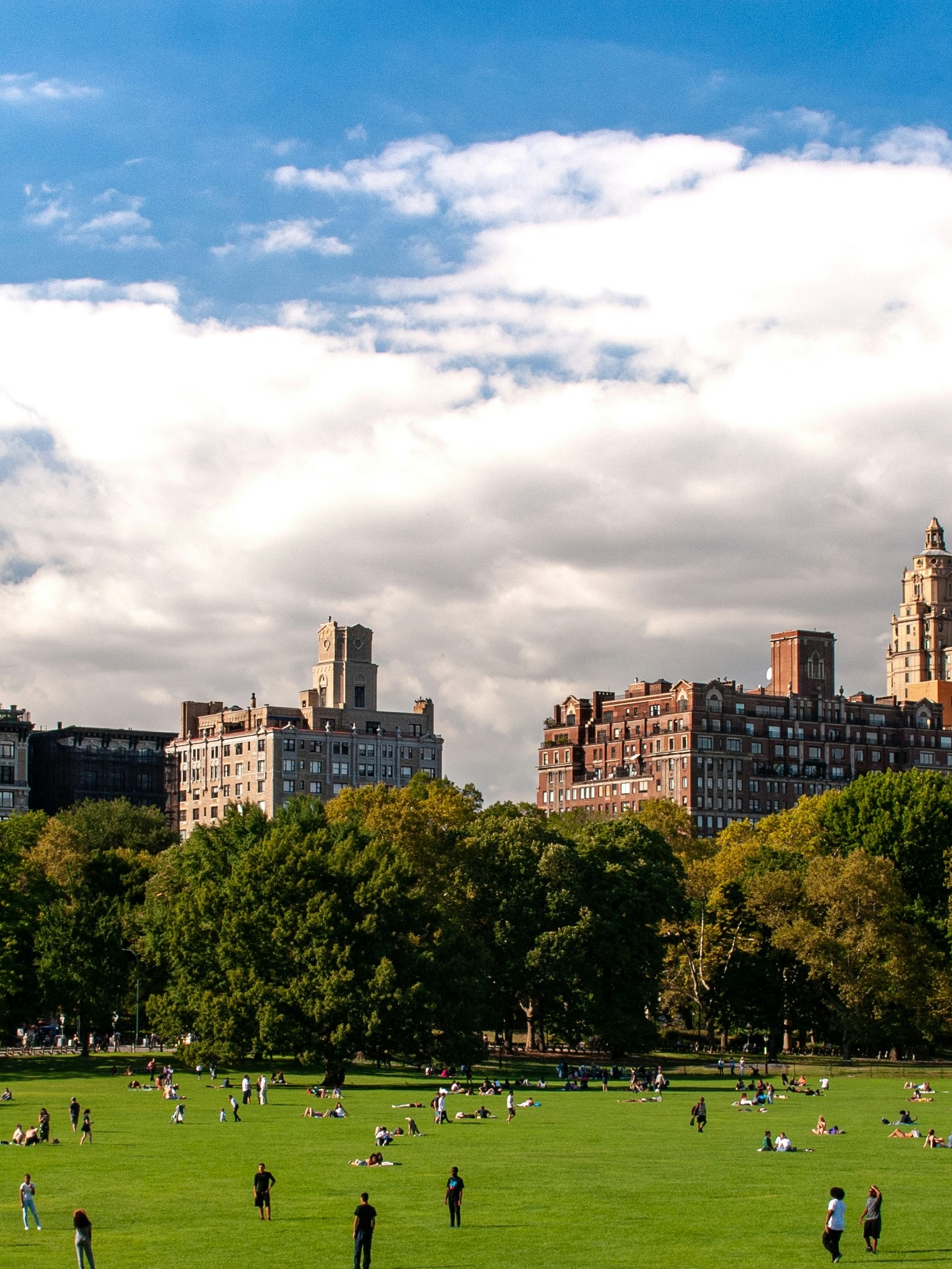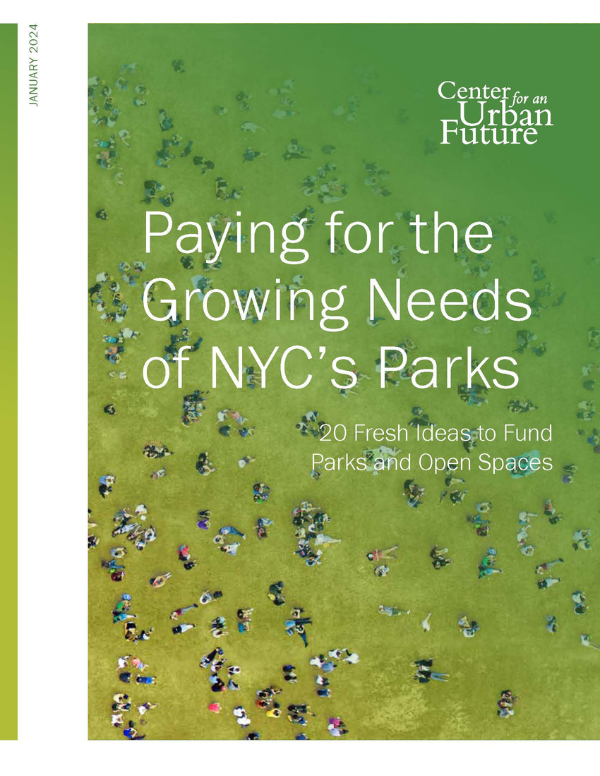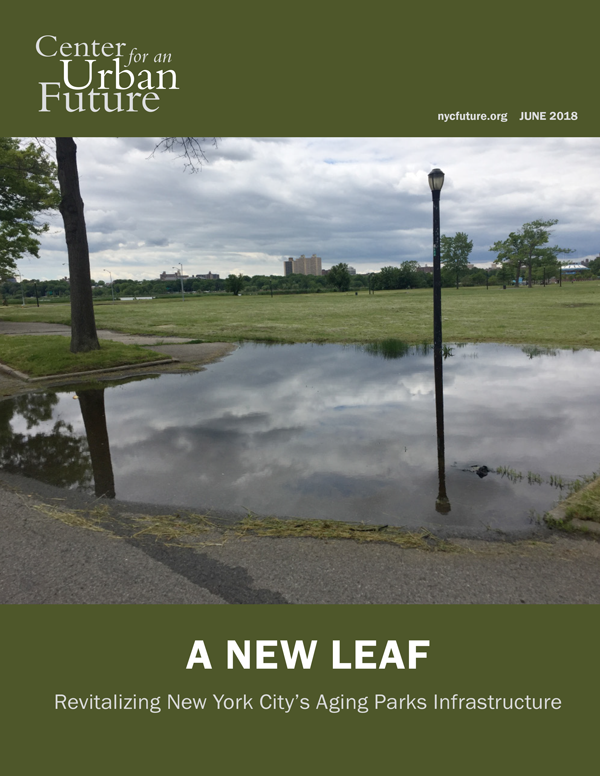New York City has undergone a public space transformation in recent years. The city continues to add acreage of parkland and green space, like Starlight Park at the mouth of the Bronx River and Gansevoort Peninsula, Manhattan’s first beach along the Hudson. Pedestrian plazas are popping up everywhere from Flatiron to Flatbush. And pandemic-era programs for outdoor dining and Open Streets, such as Jennings Street in the Bronx and 34th Avenue in Jackson Heights, are reimagining how New Yorkers use their streets for commerce and community.
At a time when New Yorkers are using parks and open spaces more than ever—and these places have become even more vital to the city’s future livability—the city can’t keep up with their growing needs, especially as its Parks Department absorbs a $20.1 million budget cut. Adequately maintaining the city’s public parks and open spaces will require sustained public investment.
But a smart strategy should also include new efforts to make it far easier for nonprofit organizations and community groups to help care for these spaces. This can usher in enhanced maintenance, site-specific programming, and dedicated new sources of revenue—allowing organizations to generate dollars from concessions and fundraisers to reinvest in their public spaces. It’s a win-win for the city and its residents.
The problem is that lawyers in the city’s Law Department are not instructed to see it that way. On the contrary, lengthy and sometimes contradictory legal reviews make securing the necessary agreements between community-based organizations and city agencies an arduous slog, costing nonprofits and volunteer groups time and money and dissuading others from even trying to forge agreements to help care for their parks in the first place. Overhauling these policies and processes would not cost the city anything while unlocking significant opportunities to improve conditions in smaller and under-resourced parks.
These bureaucratic roadblocks contribute to an inequitable landscape: community groups from the Bronx to the Rockaways want to raise funds, organize volunteers, apply for discretionary funding to support public realm maintenance and care, and support vibrant, clean, safe public spaces just like those enjoyed in better-resourced communities. But a pervasive culture of “no” in the Law Department and within other agency legal teams, the absence of a handbook for community groups to follow, and challenges raising start-up capital to cover city-imposed costs, like insurance, are stymying the ability of local groups to care for their local parks and open spaces.
This is an entirely solvable problem—and one that doesn’t require any new city expenditures. Mayor Adams should instruct the city’s lawyers to enable, rather than stifle, the public-private partnerships crucial to maintaining and enlivening the city’s parks and open spaces. With this directive, the city’s Law Department could develop new practices to facilitate faster turnaround times for renewing existing agreements and speed the execution of new ones—standardizing templates, reforming requirements, and maximizing the benefits that these agreements can generate—rather than focusing almost entirely on mitigating the perceived risks. City Hall should also work with NYC Parks to reduce the requirements for individuals and organizations to start new groups that will care for their local parks, especially in underserved communities—lowering costs for community-based organizations in a way that costs the city nothing.
The potential is clear. In neighborhoods citywide, parks conservancies and “Friends Of” organizations—from the Van Cortland Park Alliance to the Friends of Brownsville Parks—help keep the city’s green spaces healthy and vibrant by mobilizing volunteers, cleaning up trash, caring for trees and plantings, facilitating programming, and working with government to identify and address unmet needs. In recent years, a growing number of grassroots community groups have sprouted up with the goal of helping care for the open spaces in their communities. Their efforts can help address the consequences of years, if not decades, of insufficient funding for parks maintenance needs, as well as the lack of support for open spaces that fall outside of NYC Parks’ jurisdiction—from roadway margins, dead-end streets, and nature trails, to the areas underneath highways and elevated rail lines. Today, NYC Parks has 29 such agreements in place, with an additional 12 in development, while many other parks receive care from grassroots groups without a formal agreement.
These public-private partnerships offer an invaluable service to New Yorkers: local groups know their communities better than bureaucrats do; they can be adaptive to community concerns, while solving problems much more nimbly than government; and they can generate buy-in among their neighbors in ways that city agencies often struggle to do. They also offer a pathway to raising much-needed revenue for under-resourced local parks and open spaces that can stay within that park, rather than flowing into the city’s General Fund, as is the case with concessions revenue generated by NYC Parks itself.
Fortunately, there are signs of progress from the Adams administration and NYC Parks in making it easier for civic-minded New Yorkers and nonprofit organizations to help steward the myriad public spaces used by residents today. The administration’s chief public realm officer, Ya-Ting Liu, recently announced several new initiatives designed to help improve public space management, including a Public Space Academy to help train community partners around activating public spaces. The city has also committed to revising maintenance agreements for streetscapes, plazas, and parks, as recommended by the New New York: Making New York Work for Everyone Action Plan, and offer additional clean-up support to business improvement districts (BIDs).
Crucially, NYC Parks is partnering with City Parks Foundation to establish New York’s first Citywide Parks Network, a key step toward more effective and connected partnerships between grassroots and nonprofit parks groups and the agency. This network has the potential to equip groups with the support needed to navigate legal agreements and other requirements more easily. Importantly, the coalition of philanthropic foundations that make up the NYC Green Fund is planning to boost giving in the years ahead, growing the capacity of existing partner groups and catalyzing new ones in underserved areas.
But achieving these goals will only be possible if the city takes decisive action to reform the legal review process and put in place simple templates and clear guidance. Without these changes, community groups that step up to help care for their local open spaces will continue to be met not with gratitude and support from City Hall lawyers, but rather an unending spool of red tape.
A livable city is home to a vibrant, well-maintained public realm. While New York has made strides in working more effectively with partner organizations who want to see these spaces thrive, there is much more work to be done to unlock their full potential.
Three Key Challenges Inhibit Community-Led Efforts to Care for Parks and Open Spaces
A systemic “culture of no” persists. Both experienced parks alliances and friends of organizations, as well as more nascent community groups, agree: the current approach of the city’s lawyers negotiating legal agreements with parks and open space management groups is highly risk-averse, unnecessary complex, and painfully slow. The Law Department’s approach is rooted in a culture that values minimizing legal liability above all else. But while this is an understandable perspective given the possibility of costly lawsuits or accusations of corporate overreach, the pervasive culture of “no” is having the perverse effect of making the city less efficient, leaving dollars on the table, and undermining the willingness of outside organizations to help.
Data suggests that parks and open spaces are arguably the area of city operations with the lowest risk of exposure to liability claims. In FY 2022, settlements related to Parks and Recreation made up the smallest fraction (2 percent) of personal injury claims and settlements by type, amounting to $11 million out of nearly $700 million. By comparison, settlements and judgements related to roadways totaled $47.7 million, schools saw settlements of more than $70 million, and civil rights settlements totaled more than $143 million—more than 13 times that of parks.
“The commissioner or mayor can always terminate [these license agreements] at any time if they are not working out, so the risks are low,” says Chris Rizzo, a lawyer with expertise in land-use law who has worked on license agreements and served as the former chair of the Friends of Van Cortlandt Park. “But the benefits for parks could be really huge by allowing groups to bring in alternative revenues into parks to supplement their maintenance.”
A license agreement with the City of New York can run over 100 pages for parks groups; the ones for all conservancies, when stacked together by advocates, were over a mile long. Even though these types of agreements present little risk to the city with major benefits, the back-and-forth can stretch on for years and the process is rife with inconsistencies that limit their effectiveness. For instance, one organization can launch an “Adopt a Bench” program to raise much-needed maintenance dollars; another is barred from doing so. One conservancy can hold ten or more fundraising events, like galas and benefits, throughout the year; another can only host one or two. One parks alliance can garner funds from an on-site concession, like a café or eatery; another is excluded from this potential revenue source.
Parks advocates who have navigated this process say that NYC Parks’ legal staff are stretched thin, creating backlogs when contracts are being negotiated. What’s more, the opinions of an agency lawyer might not align with those of the city’s Corporation Counsel, which must approve all agreements. Even a small wrinkle between city attorneys can upend the process. “We were told that everything was good from NYC Parks, but then the city’s lawyers told us a different story,” says the head of a nonprofit group seeking an agreement to help care for plantings in parks, who requested anonymity as negotiations with the city are ongoing. “We basically had to go back to square one.”
There is no playbook for groups to help care for parks. Only a small fraction of the city’s more than 1,700 parks has a group or organization with a formal agreement in place for its sustained upkeep. But there is pent-up demand, especially in the wake of the pandemic, among residents and community groups to step up. For example, it’s a license agreement that allows Madison Square Park Conservancy to pay for maintenance and programming by holding onto more than $1 million in concession sales each year from the popular Shake Shack located there. Central Park Conservancy’s agreement allows the organization to lead capital projects, like its ongoing renovation of the Harlem Meer, saving the city time and money. And the New York Restoration Project leverages its agreement to help care for 52 parks and community gardens in underserved communities across all five boroughs.
These agreements vary significantly by agency: neighbors seeking to start an Open Street will require an agreement with the Department of Transportation (NYCDOT), while a volunteer group looking to care for a small, local park or maintain a nature trail must contact the New York City Department of Parks and Recreation (NYC Parks), and a group seeking to improve a neglected area beneath an elevated rail line will require an agreement with the Metropolitan Transportation Authority (MTA). Contract structures, terms, and conditions differ, with significant customizations needed to address the unique qualities of the public space itself, the needs of the group caring for it, and the differing approaches that government agencies have taken toward these sorts of agreements in the first place.
But in the end, the growing number of organizations seeking to help manage government-owned spaces are often left to figure things out themselves, which presents a major barrier to equitable participation for groups with limited financial resources. Even larger organizations run into unnecessary roadblocks. City Parks Foundation, the preeminent nonprofit organization for citywide parks programming, depends on concessions revenues, sponsorship, and license agreements to operate Central Park’s SummerStage and Swedish Cottage Marionette Theatre, which both raise funds that pay for programming in underserved neighborhoods. Obtaining those agreements not only costs money and time—one agreement has taken the city’s Law Department over a year to review and is still not complete, cutting off puppet shows as spring started—but also institutional knowledge and connections, which makes it much harder for groups just getting started.
“The bigger conservancies have the resources to figure this process out, and even then, it’s still hard,” says Heather Lubov, executive director of the City Parks Foundation. “But the smaller conservancies [and “friends of” groups] don’t have as much power, and these are the folks who need it even more than we do.”
Government requirements drive up costs, putting agreements out of reach for many small groups. This intense level of scrutiny comes at a cost. Permits are needed for nearly every event held in a public space, no matter if it’s a yoga class or a small concert, and if city or state government officials provide funding, they do so on a reimbursement basis, which means organizations must front the money and wait months, if not years, to be paid back. Even organizations who have worked alongside the city for years have to deal with lengthy permitting paperwork and increased staffing demands—which many groups often can’t afford—to meet the city’s requirements. And then hope it doesn’t rain.
But perhaps the greatest cost barrier is insurance. The city does not indemnify private groups, requiring them instead to hold their own insurance to cover the public space they maintain—which is one of the steepest costs of doing business for these nonprofit and volunteer organizations.
The smallest of permits for Open Streets events, for example, requires that a group maintain $1 million in commercial liability insurance. If a group is maintaining a built structure on parkland, they must procure eight different types of insurance, including property insurance, which is currently experiencing record-high rates due to inflation and a shrinking market of insurers. Similar requirements are imposed on groups seeking to do even simpler things, such as build planters, host community clean-up events, or hold composting workshops. And unless the entity is backed by a fiscal sponsor, it must be registered as a nonprofit to receive city funding, which then requires directors and officers (D&O) insurance. Bundled together, this can cost at least $300 to $500 a month—and that’s if the group can even find an insurance company that is willing to underwrite these sorts of highly specialized policies.
Given the complexity of these license agreements, private groups often feel obligated to hire lawyers for review, sometimes patching together neighbors’ donated dollars to pay them. Independent counsel starts at $150 per hour and can go much higher, and it can take months, if not years, to finalize a license agreement. This leaves groups in a legal limbo for extended periods of time, where they have little ability to raise funds or conduct operations.
As a result, groups sometimes avoid telling city or state agencies about work they’re undertaking, to avoid scrutiny and hassle. In fact, many groups citywide are actively maintaining public parks and open spaces without a license agreement in place. “There’s no end in sight,” said the head of one that maintains a popular park in Brooklyn, who requested anonymity out of fear of repercussions from city officials. “But we can’t just wait around to take care of this crucial space for neighbors.”
Signs of Progress
The city has made strides in making it easier for private groups to maintain and care for public space. Perhaps most notable is Mayor Adams’ appointment of Ya-Ting Liu, the city’s first chief public realm officer, whose team now acts as an important conduit for groups looking to activate open spaces. Her office is also helping streamline interagency coordination through an emerging Public Space Avengers interagency group, and advocate for—and accelerate—projects in underserved communities through the new Public Space Incubator.
NYC Parks is taking important steps of its own. Under the leadership of Commissioner Sue Donoghue, who previously led the Prospect Park Alliance and has first-hand knowledge of the challenges that partner groups face, the agency has teamed up with the City Parks Foundation to launch a Citywide Parks Network, the first effort of its kind in New York City. Informed by extensive consultation with existing parks partner groups, the network has the potential to streamline the process for grassroots and nonprofit organizations to partner with the city and provide a level of guidance and support that has long been needed.
NYC Parks has also launched a new Vital Parks Explorer tool, which captures existing partner groups and stewardship opportunities and highlights those neighborhoods that currently lack access to partner groups and would benefit from their creation and development.
Beyond the parks system, the city is starting to standardize license agreements for BIDs, so they’re less time-intensive and costly to undertake. In the face of rising insurance costs, City Hall recently announced a “trusted partner” pilot; while details have yet to be outlined publicly, the idea is that BIDs will benefit from the removal of some of the most cumbersome city-imposed requirements, including around insurance, and streamline the length and number of agreements needed to operate. (NYC Parks reports that modifications limiting liability for BIDs have started to be applied to some parks partners seeking to assist in the maintenance of parkland.) The Adams administration has also created a new grant program to help offset insurance costs for smaller BIDs.
The Department of Transportation’s Open Streets program has also made headway in providing community groups with better navigation. There is a clear online application process, and applicants can schedule consultations with DOT staff. There are orientations and workshops to explain invoicing and revenue-generating options, like sponsorships and short-term concessions, where organizers can facilitate markets and receive donations in return. And newly codified rules have helped to somewhat improve the permitting process, while some community partners have received pro bono counsel through nonprofit organizations like the Lawyers’ Alliance for New York. The license agreements also run only a few pages long. Additionally, the agency has expanded its work with the Horticultural Society, a century-old community beautification group, to clean and care for plants on plazas and Open Streets citywide.
Groups dedicated to maintaining green spaces have received long-standing help from Partnerships for Parks, a collaboration between City Parks Foundation and NYC Parks to train groups hoping to care for their local parks and playgrounds. When Partnerships for Parks is involved in agreement negotiations, insurance requirements may be different. NYC Parks is also working to roll out a “license agreement lite,” which is said to be shorter with a quicker turnaround time.
Together, these promising initiatives—if implemented and maintained at scale—will allow more communities to benefit from cleaner, livelier public spaces by harnessing the potential of private help to offer enhanced care and funding. But more can be done to ensure that every New Yorker is afforded access.
Four Recommendations for Making It Easier for New Yorkers to Care for Their Parks
New York City’s public space awakening presents an incredible opportunity for New York City to become a greener, safer, and more attractive place to live. But to reach its full potential, the city should do everything it can to support the nonprofit organizations, community groups, and civic-minded residents working every day to make that vision possible. Here are four next steps that city government should take to help.
Direct the city’s lawyers to simplify agreements around parks and open space care. If City Hall is intent on creating a “City of Yes,” Mayor Adams and his commissioners should instruct their respective law departments to put their sharpest legal minds to work streamlining agreements and finding efficient ways to offer groups greater flexibility in raising revenue that can help fund their operations. While overbearing legal review is a significant barrier to progress today, creative legal engineering can be a core part of the solution—but this will only happen with clear direction from the mayor and agency leaders. NYC Parks will also need additional resources to support staffing needs in its legal department.
Thankfully, the city doesn’t have to look far for potential models. The agreements for state park partners, like Four Freedoms Park Conservancy on Roosevelt Island and Friends of Gantry Plaza State Park in Long Island City, are no more than five pages. Philanthropic partners who work with the National Park Service to fundraise for federal parkland care, like the Ellis Island Foundation or the Jamaica Bay-Rockaway Parks Conservancy, fill out a document of a similar length. Distinct characteristics of each public space are simply addressed in a one-page addendum.
“The City has its reasons for slow-walking negotiations on park operation and maintenance agreements,” says attorney Chris Rizzo. “But they are primarily policy issues, not legal issues. And the City could speed up the process tomorrow if it wanted to.”
Develop a public space management handbook that includes parks and open spaces. The city receives an immense benefit from the dedicated work of its private partners, from the conservancies taking regular care of the city’s signature parks to the smaller volunteer groups leading clean-ups. So, officials should make it as easy as possible for groups to do that work. Mirroring the Open Streets model, the city should produce a readily available handbook for all entities seeking to help care for parks and other open spaces, with a step-by-step guide for developing agreements with NYC Parks and other government agencies, sample contract templates, and examples of existing models and agreements, with a focus on insurance and other city-mandated requirements and options for revenue-generating arrangements. Ultimately, the city should develop an online application form for all public space management and maintenance proposals and enable groups to schedule consultations with navigators embedded in each relevant agency.
Reduce the overhead costs for groups that support the needs of public parks and open spaces—starting with insurance. If the city is going to make public space management more equitable and effective, then it should take action to help reduce overhead costs. The city and state should start by reducing or eliminating certain insurance requirements and clarifying government’s responsibilities in areas where community groups should clearly not be held liable. To help bring down insurance costs further, the city and state could help form a risk retention group insurance consortium comprised of every public space management organization in the city, pooling demand to lower costs and incentivizing competition. In the interim, the city should expand its new $500,000 grant program for offsetting insurance costs for smaller BIDs and make it available to organizations that care for parks and other open spaces. The city should also launch new programs aimed at providing free and low-cost technical assistance to public space management organizations, perhaps by developing an RFP for organizations to connect community groups with pro bono and sliding-scale legal counsel.
Ensure that the city’s proposed Public Space Academy includes parks groups. Today, far too many of the civic-minded New Yorkers who are eager to help care for their public spaces find their energy and resources drained by the lengthy and cumbersome process of city approval—and few organizations know of anywhere to turn for help. To change this, the Office of the Public Realm is working to create a Public Spaces Academy, an initiative that would help coach new and emerging public space management organizations through the process of setting up operations and developing agreements with relevant agencies. Park groups must be included in that conversation, as the problems it is trying to address stretch beyond the streetscape. This one-stop shop could help organizations develop plans to care for parks, community gardens, asphalt conversions, waterfront properties, and other green spaces. It could pair new applicants with a navigator based in the relevant city agency, including the NYC Parks; host workshops on key issues like insurance coverage and revenue-generating activities; convene interagency meetings to address thorny jurisdictional issues that often cause delays; and help pilot the care of smaller parcels of land within a park or open space, so groups can start small and grow over time.
_300_388_bor1_a4a4a4.png)





